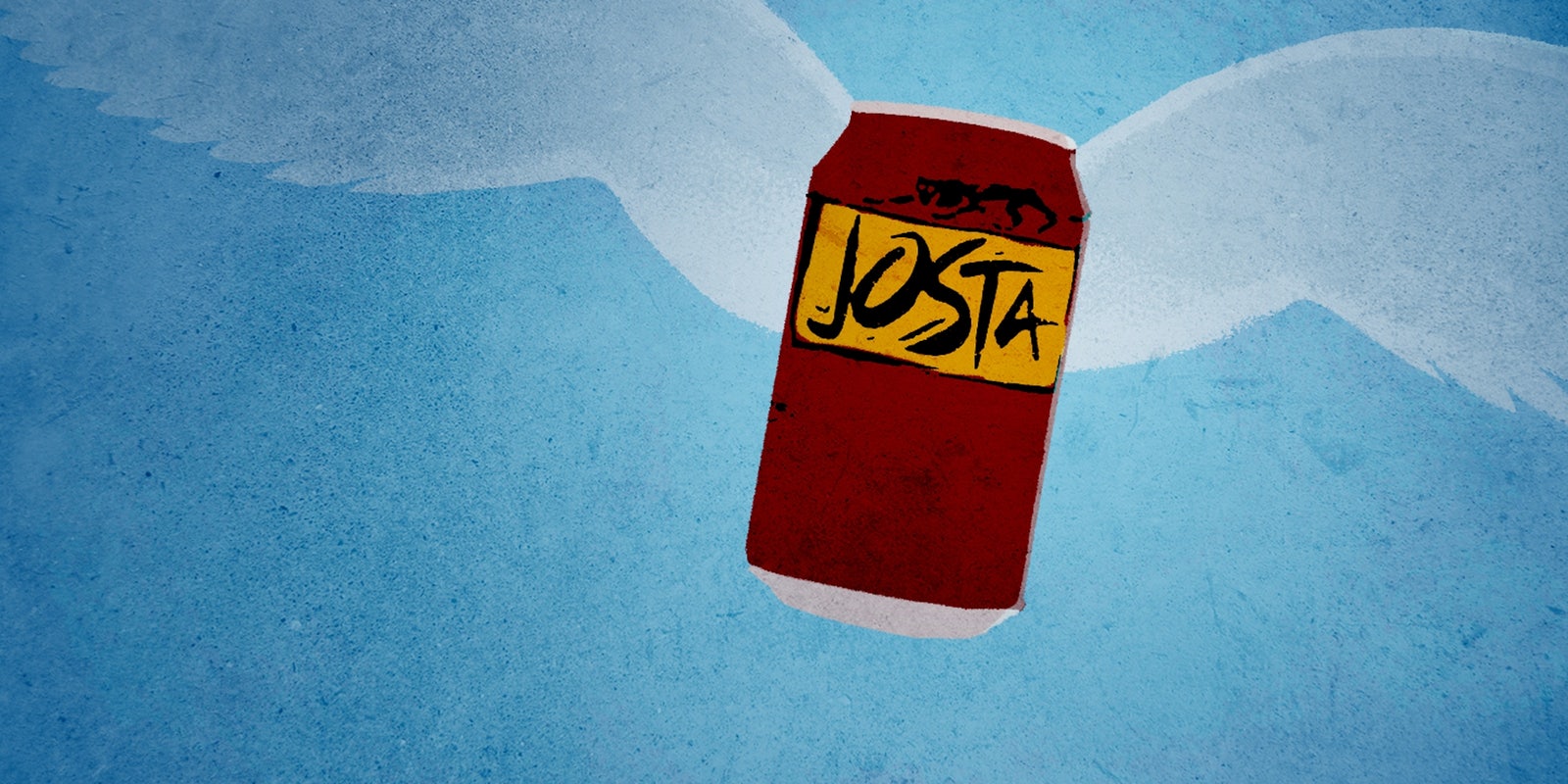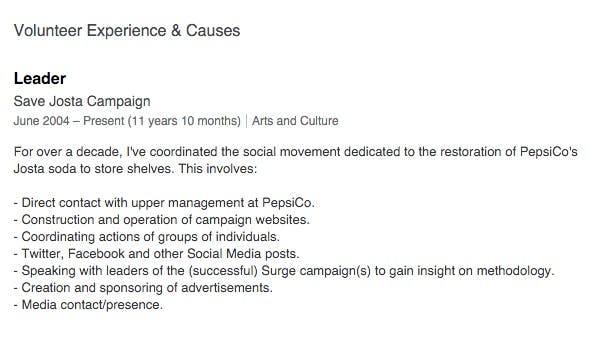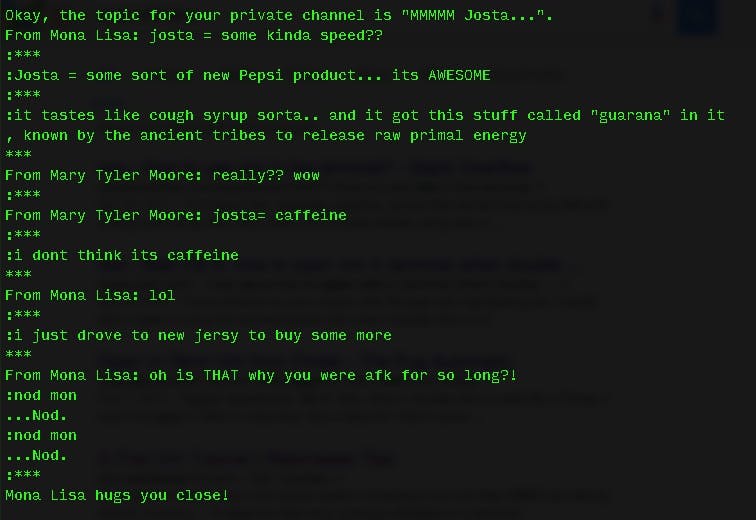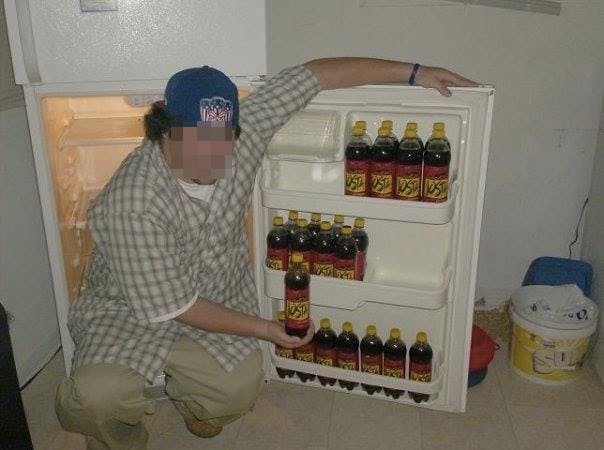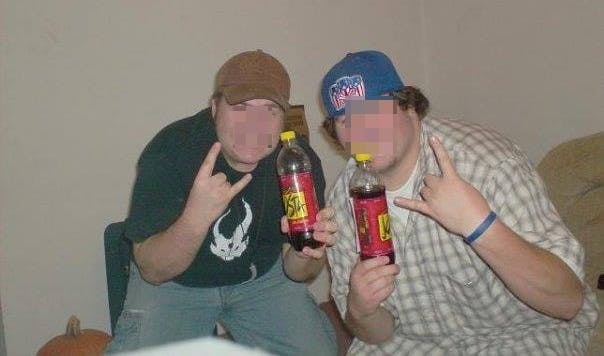I still remember the first time I saw Josta. It was 1997, and I was in middle school, sitting on the bus home while we waited for the high schoolers to come aboard. I was a dork, and the only older kids who deigned to talk to me were dorks, too. Among them, one guy stood out: He was taller, he was cooler, he was black, and he was the best at Magic cards. Here he came down the aisle, with his backpack, ‘fro, and something else: a bottle of soda I had never seen before. Red-and-yellow label. A panther on it.
Josta. What the hell was Josta?
“Power of Wu-Tang,” he said, shuffling up his cards and winning a few games of Magic as the bus proceeded toward our neighborhood.
It would be a couple more years before I figured out who the Wu-Tang Clan were, but if “Josta” was this kid’s secret, I wanted some. In the days before Coca-Cola signed contracts with school districts to deal Coke in every building, one thing the high schoolers had over us younger kids was their Pepsi machine. I gave my idol a buck and asked him to bring me a Josta after school the next day.
He delivered, and it was glorious. I really tried to taste the mythical “Wu-Tang” (whatever that was) stirred up with guarana (whatever that was), which took up prime real estate on the label: “Josta with guarana.” It tasted like cola, but fruitier—complex and exotic, kind of grown-up. I could feel myself getting cooler and smarter with every gulp.
Josta was more than a placebo. It was Pepsi‘s first stab at an energy drink, before the energy drink craze really took off—a product ahead of its time. It seems tame now that the caffeine arms race has given us weapons-grade five-hour energy shots, but to a scrawny 13-year-old in the ’90s, the buzz Josta provided was novel and powerful.
It wouldn’t last. Josta, introduced in 1995, was discontinued in 1999.
I don’t remember seeing this commercial when it aired, but now it plays like an elegy for the product: “Better do the good stuff now.”
I’ve thought about Josta a few times since then, but only as a pleasant memory from childhood, buried in a Y2K time capsule along with Napster, Bondi Blue iMacs, and Nickelodeon Floam. But for some people, trying to get just one more taste is a hobby bordering on obsession.
The King Crazy
Jason Latona has been campaigning since 2004 for Pepsi to bring Josta back.
An IT engineer who says he’s been missing Josta for 16 years, Latona has launched petitions and spoken to PepsiCo management, built websites, and tried at all times to give fellow Josta fans a focal point to rally around.
He even lists his long-running Save Josta Campaign on his LinkedIn page:
“When I first tried Josta, I guess it was the novelty of the flavor that was the attraction,” Latona told me in an email.
“The market is full of status quo: Pepsi Cola itself was formulated in 1893. Looking back on it, I drank [Josta] during a transitional part of my life; I was just out of high school, and I have a lot of good memories associated with it.”
“I actually have 2 full bottles of it, but they’re too aged and precious to open.”
The peak of his success to date was in organizing a National Josta Day on April 4, 2007, after which PepsiCo representatives tracked him down.
“They didn’t have my phone number,” he said, “but somehow found my mother’s.”
The conversation didn’t lead to a Josta revival, and the Pepsi VP he spoke with has since moved on. But it was better than a form letter, and for Latona, it was enough to keep going. Nearly a decade later, he’s still pushing to get Josta back onto the shelves.
“I actually have 2 full bottles of it, but they’re too aged and precious to open,” he wrote. “I also have an empty bottle with a bit of dried Josta settled on the bottom. It still smells good: It’s fruity, almost an aspect of bubbleguminess.”
Latona describes himself as the “King Crazy” of the Josta revival movement, but he’s not alone. Although the true Josta die-hards are few in number, they’re very dedicated.
‘Chasing the Panther’
Jim S. has been hooked on Josta since New Year’s Day 1997. He had his first sip at a small New Jersey convenience store and liked it so much that he arranged for the owner to order an extra case every few weeks—just for him.
Lest you doubt his immediate passion for his new discovery, Jim has provided the chatlogs from an online bulletin board system (remember, this was 1997) in which he told his friends about this new drink they absolutely had to try: “dude i got the MOST kick ass soda today,” he wrote to a friend, “this soda has ‘guarana’ in it. it seriously has a vicks/robitussen flavor and it kicks ass … im taking you down to new jersey so you can get some of this stuff.”
After Josta disappeared in 1999, Jim and his friends sampled every new energy drink that hit the market, hoping for something similar but striking out every time.
“It was nothing but ‘Chasing the Panther,’ if you will. … Years passed, drinks came and went, but Josta was always on our minds,” Jim told me.
Then, one day, he had a epiphany at McDonald’s. He’d mixed up strawberry Fruitopia and Coke, and the taste brought back memories. It wasn’t quite Josta—Josta used dragonfruit, not strawberry—but it was close enough that he figured he might be able to make his own.
His original recipe combined Pepsi for the cola taste, Bawls energy drink for the guarana, and Sobe Dragon for the dragonfruit. After tweaking the ratios to his liking, he posted the recipe online in 2005. He called it “Josta Reborn.”
“Josta Reborn has nearly the same red tint, same nasal-clearing aroma, and same flavor bite as I remember Josta having (and I have a bottle of Josta still to compare it to),” he wrote at the time.
“I had also explored different extract and concentrates, but part of what I wanted to create was something that was easy for other Josta fans to make without having to place special orders or go to a bunch of stores looking for ingredients,” Jim told me.
“Josta Reborn has nearly the same red tint, same nasal-clearing aroma, and same flavor bite as I remember Josta having.”
But dragonfruit fell out of fashion in the mass-market beverage world, and Sobe Dragon disappeared, along with Jim’s backup plan, Snapple Elements: Fire. Anyone chasing the panther today must resort to a diluted alternative: dragonfruit VitaminWater. (I note, not without irony, that the only thing keeping a discontinued Pepsi product alive is owned by Coca-Cola.)
Although he hopes as much as anyone that Pepsi will have a change of heart—or, more likely, spot some marketing opportunity—and resurrect Josta, he’s sober and realistic about the prospects.
“Do I think they will ever bring it back? I don’t want to be negative and say no,” he wrote, “but it sure seems like a lost cause based on Pepsi’s responses to us so far… unless we can rally a new, larger group of fanatics behind the idea.
“Till then, I’ll keep plugging away at easy ways to make a good homemade version.”
Spam 4 Josta
The man behind the Josta Facebook page, who uses the alias “Ed Carter,” has been working on bringing back the cult energy drink since 2008.
He and his brother Tony, who introduced him to the drink back in the ’90s, organize an annual “Spam 4 Josta Weekend,” a coordinated assault on all of PepsiCo’s social media pages with pro-Josta messages.
The Carter brothers were inspired to start their page eight years ago, when they stumbled upon Jim’s DIY version of their favorite soda.
“Back in 2008 I discovered the ‘Josta Reborn’ recipe, which called for a 24oz bottle of Pepsi, 1/4 cup of Bawls energy drink and 3/4 cup of dragonfruit flavored VitaminWater,” Ed Carter told me.
“Tony and I both concluded that it was the closest thing to Josta we’d had in years. So I made a whole case of them and stocked his apartment fridge with them for his birthday.”
Their case only lasted about a week and a half, but they were hooked. They started the Facebook page soon afterward.
Since then, they’ve made a few more bottles of Josta Reborn, but it was never quite as thrilling as that initial experiment, tasting a long-gone flavor for the first time in a decade.
The Carters’ Spam 4 Josta campaign has seemingly hit a brick wall, too.
“The responses we kept getting back were the standard automated responses,” Ed Carter told me. “Something to the effect of ‘Thanks for your feedback! We really appreciate your input. Right now, Josta is not currently in production by PepsiCo. We are however committed to providing our customers with the best beverage and snack selection available…’”
Then Tony ran into some unrelated legal trouble, and Josta went on the back burner. It’s been a while since the brothers have mixed up a batch of Reborn together.
The number of Josta fanatics there to take up the banner is modest: just 2,500 people follow their Facebook page.
Josta Reborn?
Jason Latona isn’t giving up, but 1997 gets further away every day, and life gets in the way.
“I have about 4,000 signatures on a petition, but the number of people who actually participate are rather few. I get it, it’s not like we’re pushing for a cancer cure, and people are busy. Heck, I’m even too busy,” he told me.
But the future might not be entirely bleak for adherents of the temple of guarana. If there’s one thing the Internet—and, by extension, the Internet marketing apparatus—loves, it’s a ’90s nostalgia revival. It’s most prominently expressed in the form of BuzzFeed listicles, but it’s common knowledge that the middle-schoolers of the ’90s are today’s gainfully employed millennials. We miss our sunny, pre-9/11 childhoods. We’ll buy them back, and marketers are happy to sell them to us.
Remember Surge, Coke’s edgy, x-treme contribution to the neon-green soda genre dominated by Mountain Dew? Its birth and death overlapped almost exactly with Josta’s, but it came back in 2014 as a result of a fan movement. You can only get it on Amazon, but that’s better than nothing. In fact, Coke praised “the three Millennials behind The SURGE Movement, a passionate community of more than 148,000 (and counting) Facebook fans.”
Could Pepsi one day praise the guys with fridges full of homemade Josta? Or the guy who evangelized the stuff on BBSs before “social media” was even a twinkle in Mark Zuckerberg’s eye? Or the guy who has put so much of his life into Josta that he mentions it as an accomplishment on his LinkedIn page?
You can’t say they haven’t worked hard enough, but the fact remains that Josta can only claim a few thousand fans. PepsiCo, whose representatives didn’t respond to a request for comment on this article, doesn’t appear to be moved by those numbers.
Josta Reclaimed
There might be a backdoor into the Pepsi empire. In September 2015, Pepsi expanded its relationship with SodaStream, makers of a popular countertop soda machine. Now you can buy Pepsi and Sierra Mist syrups and make your own at home.
The Josta faithful, sensing an opportunity, are now angling to bring the panther back in concentrated form.
@SaveJosta @JostaMovement Your passion is impressive! We received your petition and will review it.
— SodaStream USA (@SodaStreamUSA) December 10, 2015
“Last year, I approached SodaStream with the idea for a Josta syrup now that they have a licensing deal with PepsiCo. Last I heard, they were reviewing the matter,” Jason Latona told me.
Jim, too, thinks the future of Josta might go through the SodaStream. He’s taking a new angle for his next Josta Reborn recipe.
“I have also started to explore more on the extract and concentrate side of things, and actually may have a half decent Syrup Recipe soon, which could then be used at home with something like a SodaStream kit.”
One thing that becomes immediately evident as we watch #brands and #content providers sift through our ’90s childhoods is how thoroughly those childhoods were defined by products: the texture of Gak and slime, the sound of theme songs for cartoons that were just half-hour ads for toy franchises, the smell and taste of a discontinued soda.
There’s something sad and frustrating, but very American, about pleading in vain for a corporation to let us consume the same things we consumed in our halcyon days, times we remember as happier and simpler. What do you do when a company doesn’t even want your free marketing? When you want something so badly that you can literally taste it—at least in your sense-memory—and a multinational high fructose corn syrup dealer just keeps withholding it?
It’s also noble—and very American—to take matters into your own hands, throwing up a middle finger to the free market and mixing your own damn sugar-water. It’s not as perfect as you remember, but it’s yours. You drink it, and all those memories come flooding back. Hanging out with your brother, driving to New Jersey with your friends from the Internet, losing card games to the coolest dork on the bus. You don’t need anybody’s permission.
This homebrew stuff, this off-label, no-label Josta? It’s not Josta Reborn. It’s Josta Reclaimed. And that’s the power of Wu-Tang.
Illustration via Max Fleishman

